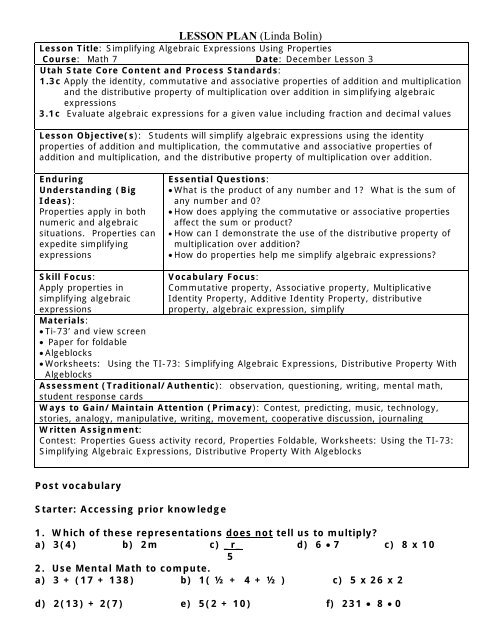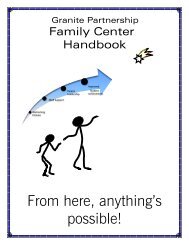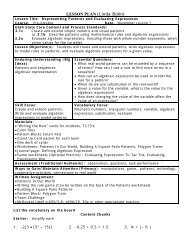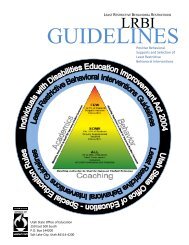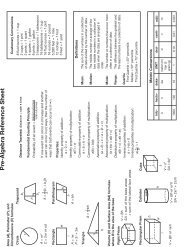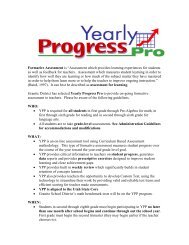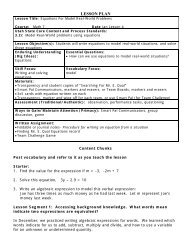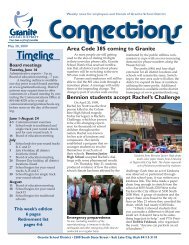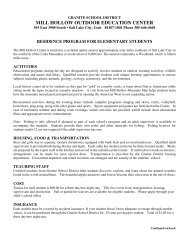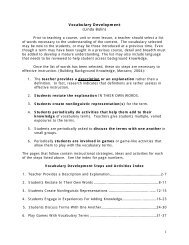LESSON PLAN (Linda Bolin) - Granite School District
LESSON PLAN (Linda Bolin) - Granite School District
LESSON PLAN (Linda Bolin) - Granite School District
You also want an ePaper? Increase the reach of your titles
YUMPU automatically turns print PDFs into web optimized ePapers that Google loves.
<strong>LESSON</strong> <strong>PLAN</strong> (<strong>Linda</strong> <strong>Bolin</strong>)<br />
Lesson Title: Simplifying Algebraic Expressions Using Properties<br />
Course: Math 7 Date: December Lesson 3<br />
Utah State Core Content and Process Standards:<br />
1.3c Apply the identity, commutative and associative properties of addition and multiplication<br />
and the distributive property of multiplication over addition in simplifying algebraic<br />
expressions<br />
3.1c Evaluate algebraic expressions for a given value including fraction and decimal values<br />
Lesson Objective(s): Students will simplify algebraic expressions using the identity<br />
properties of addition and multiplication, the commutative and associative properties of<br />
addition and multiplication, and the distributive property of multiplication over addition.<br />
Enduring<br />
Understanding (Big<br />
Ideas):<br />
Properties apply in both<br />
numeric and algebraic<br />
situations. Properties can<br />
expedite simplifying<br />
expressions<br />
Essential Questions:<br />
• What is the product of any number and 1? What is the sum of<br />
any number and 0?<br />
• How does applying the commutative or associative properties<br />
affect the sum or product?<br />
• How can I demonstrate the use of the distributive property of<br />
multiplication over addition?<br />
• How do properties help me simplify algebraic expressions?<br />
Skill Focus:<br />
Apply properties in<br />
simplifying algebraic<br />
expressions<br />
Vocabulary Focus:<br />
Commutative property, Associative property, Multiplicative<br />
Identity Property, Additive Identity Property, distributive<br />
property, algebraic expression, simplify<br />
Materials:<br />
• Ti-73’ and view screen<br />
• Paper for foldable<br />
• Algeblocks<br />
• Worksheets: Using the TI-73: Simplifying Algebraic Expressions, Distributive Property With<br />
Algeblocks<br />
Assessment (Traditional/Authentic): observation, questioning, writing, mental math,<br />
student response cards<br />
Ways to Gain/Maintain Attention (Primacy): Contest, predicting, music, technology,<br />
stories, analogy, manipulative, writing, movement, cooperative discussion, journaling<br />
Written Assignment:<br />
Contest: Properties Guess activity record, Properties Foldable, Worksheets: Using the TI-73:<br />
Simplifying Algebraic Expressions, Distributive Property With Algeblocks<br />
Post vocabulary<br />
Starter: Accessing prior knowledge<br />
1. Which of these representations does not tell us to multiply?<br />
a) 3(4) b) 2m c) _r_ d) 6 • 7 c) 8 x 10<br />
5<br />
2. Use Mental Math to compute.<br />
a) 3 + (17 + 138) b) 1( ½ + 4 + ½ ) c) 5 x 26 x 2<br />
d) 2(13) + 2(7) e) 5(2 + 10) f) 231 • 8 • 0
• Lesson Segment 1: (Accessing prior knowledge) What is the product of any<br />
number and 1? What is the sum of any number and 0? How does applying<br />
the commutative or associative properties affect the sum or product? How<br />
can I demonstrate the use of the distributive property of multiplication over<br />
addition?<br />
Team Contest: Use the #1 question on the starter to review properties by asking<br />
students to look at property words on the board. Tell them you can compute much<br />
faster and easier by using these properties. Have students take out a paper for an<br />
assignment activity called “Properties Guess”, and number the paper a-f. As you<br />
mentally compute each starter problem, have students quietly discuss with their team<br />
and write which property or properties they think you applied. Ask students to respond<br />
after they have written the property they think you applied. Any team who correctly<br />
identified the property(s) earns a point. You may need correct their thinking as you go<br />
over each problem. After discussing an expression, have students write the correct<br />
property and how it was applied to simplify each expression on their paper.<br />
a) 3 + (17 + 138) Use associative property to regroup adding 3 and 17 first.<br />
b) 1( ½ + 4 + ½ ) Use the commutative property to reorder ½ + ½ + 4 in<br />
the parentheses, and then multiply by 1 using the identity property.<br />
c) 5 x 26 x 2 Use the commutative property to reorder 5 x 2 x 26.<br />
d) 2(13) + 2(7) Use the distributive property to multiply the sum of 13 and 7<br />
(20) by 2.<br />
e) 5(2 + 10) Use the distributive property to multiply 5 x 2 (10) and 5 x 10<br />
(50). Add 10 and 50.<br />
f) 231 • 8 • 0<br />
Tell students these properties work for addition and multiplication with variables too.<br />
If they have their properties foldable from September Lesson 7, they could use it to<br />
compare. Make this foldable for properties<br />
with variables. Fold both edges toward the<br />
center. Clip on the dotted line to the fold to<br />
make four shutters. Inside students should<br />
Commutative Associative<br />
write examples of the application of these<br />
Properties Properties<br />
properties using variables. Work with<br />
students to write simple algebraic examples<br />
such as:<br />
Cut here<br />
Cut here<br />
a + b = b + a<br />
ab = ba<br />
(a + b) + c = a + (b + c)<br />
(ab)c = a(bc)<br />
1a = a<br />
a(b+c) = ab + ac<br />
Identity<br />
Properties<br />
Distributive<br />
Property
Lesson Segment 2: How do properties help me simplify algebraic<br />
expressions?<br />
Sing or say the Properties Song to review (attached).<br />
Accessing and building background knowledge:<br />
Tell the students when they were finding a simple answer for the operations in the<br />
contest, they were “simplifying the expression”. Give a brief explanation for the word,<br />
simplify such as, “What we mean by “simplifying an expression” is to make the<br />
expression more simple to understand or look at without changing the value of the<br />
expression.<br />
In our language we often simplify expressions. For example, we could say, “Hi there.<br />
How are you doing? Or, we could say, “Hey, Sup?” The meaning is the same, but the<br />
second expression is much shorter and simpler than the original expression.<br />
In mathematics we want to write expressions as simply as possible, but do not want to<br />
change their meaning or value. We want the simplified expression to be equivalent to<br />
the original, longer expression.<br />
Ask the following questions and have students record the examples on their Team<br />
Contest record paper.<br />
Q. When we say two expressions are equivalent what does that mean? For example<br />
when we say 3 + 1 is equivalent to 4 (or 3 + 1 = 4), what does that mean?<br />
The equal sign tells us one expression is equivalent to the other or in other words, the<br />
expressions have the same value.<br />
Q. If two expressions are equivalent, must they always look exactly the same? What<br />
makes you think so?<br />
Show examples: 2 • 6 = 3 • 4 3(2 • 5) = (3 • 2)5 3(5 + 6) = 3 • 5 + 3 • 6<br />
Q. How can we know whether two expressions are equivalent if they don’t look alike?<br />
One way to verify that two expressions are equivalent, is to simplify each expression.<br />
Example 1: 2 • 6 = 3 • 4<br />
2 • 6 simplified is 12<br />
3 • 4 simplified is 12<br />
12 = 12.<br />
So, 2 • 6 = 3 • 4<br />
Example 2: 3(2 • 5) = (3 • 2)5<br />
3(2 • 5) is 3(10) =30<br />
(3 • 2)5 is (6)5 = 30<br />
30 – 30<br />
So, 3(2 • 5) = (3 • 2)5
Example 3: 3(5 + 6) = 3 • 5 + 3 • 6<br />
3(11) = 33<br />
3 • 5 + 3 • 6 is 15 + 18 = 33<br />
33 = 33<br />
So, 3(5 + 6) = 3 • 5 + 3 • 6<br />
Tell students these ideas about equivalency and simplifying apply with variables as well<br />
as numbers. We use properties to simplify algebraic expressions. When we simplify an<br />
algebraic expression using properties, we can compare the original expression with the<br />
simplified expression to make sure they are equivalent. A simplified expression is<br />
always equivalent to the original. Students will be simplifying algebraic expressions,<br />
and then substituting values in the expressions to verify equivalency.<br />
Work with the class to complete the Simplifying Algebraic Expressions worksheet.<br />
Lesson Segment 3: How can the distributive property be applied to algebraic<br />
expressions?<br />
Using Algeblocks, work through the attached Distributive Property Using Algeblocks<br />
investigation (attached). This is a powerful visualization for applying the distributive<br />
property with variables. Make sure students build, draw and represent as instructed.<br />
Discuss their models.<br />
Assign text practice as needed.
Properties Song<br />
(to “Macnamara’s Band”)<br />
The Commutative Properties<br />
Are like an order game<br />
Whether first is last or last is first,<br />
The answer will be the same.<br />
So one plus two is two plus one,<br />
And either sum is three.<br />
And, five times eight is eight times<br />
five.<br />
Commutative Property!<br />
Chorus<br />
Oh with these properties<br />
computing can be fun,<br />
Making operations easier to be<br />
done!<br />
The Identity Property<br />
Makes numbers stay the same.<br />
How can you add or multiply<br />
And not change the number’s<br />
name?<br />
When adding, add a zero,<br />
Multiplying, times by one.<br />
The answer will be identical to<br />
The number where you’ve begun.<br />
Chorus<br />
Oh with these properties<br />
computing can be fun,<br />
Making operations easier to be<br />
done!<br />
The Associative Properties<br />
Say grouping can be fun!<br />
And, the little parentheses<br />
Show how the grouping’s done.<br />
Often, answers can be found<br />
More quick or easily by<br />
Moving parentheses around.<br />
Associative Property!<br />
Chorus<br />
Oh, with these properties<br />
computing can be fun<br />
Making operations easier to be<br />
done!<br />
Now the Distributive Property<br />
Says factors should be shared,<br />
All numbers in parentheses,<br />
With the same factor paired.<br />
So 5 times 2 plus five times one<br />
Is the same as five times three.<br />
Multiplying will be easier with<br />
Distributive Property!<br />
Chorus<br />
Oh, with these properties<br />
computing can be fun<br />
Making operations easier to be<br />
done!
Using The TI-73:<br />
Simplifying Algebraic Expressions<br />
Name _____________<br />
Look at the original expression and the simplified expression. Tell which property was<br />
used to simplify the expression. Then, substitute the given value for the variable using<br />
the TI-73 to check.<br />
To compare the original and the simplified expressions, first substitute a value. Type<br />
a value and press X I b.<br />
To compare the two expression, first press -1. Type the original expression.<br />
Then, curser to the = sign and press b. Now, type the simplified expression on<br />
the right of the equal sign. Curser to Done and press b b. If a 0 appears, the<br />
expressions are NOT equivalent. If a 1 appears, the expressions are equivalent.<br />
1. 3 + x + 7 2. 2(3x)<br />
= 3 + 7 + x = (2 • 3)x<br />
= 10 + x = 6x<br />
Property used to simplify?<br />
Substitute 2 for x and prove equivalency.<br />
Property used to simplify?<br />
Substitute 5 for x and prove equivalency.<br />
3. 1x 4. 8 + (2 + r)<br />
= x = (8 + 2) + r<br />
= 10 + r<br />
Property used to simplify?<br />
Substitute 7.3 for x and prove equivalency.<br />
Property used to simplify?<br />
Substitute 6 for x and prove equivalency.<br />
5. 4w • 5 6. 5b + 3b<br />
= 4 • 5 • w = (5 + 3)b<br />
= 20w = 8b<br />
Property used to simplify?<br />
Substitute -1 for x and prove equivalency.<br />
Property used to simplify?<br />
Substitute ½ for x and prove equivalency.
Distributive Property With<br />
Algeblocks<br />
Name _________<br />
Use the yellow piece to represent x and the green piece to represent one unit.<br />
1. Arrange 4X’s and 8 units into groups so that each group is identical to the other<br />
groups. Sketch your work. Write a variable expression using parentheses to represent<br />
your groups.<br />
2. Find another way to group 4X and 8 units so that each group is identical. Sketch<br />
your work. Write a variable expression using parentheses to represent your grouping.<br />
3. Arrange 8X’s and 12 units into groups so that each group is identical to the other<br />
groups. Sketch your work. Write a variable expression using parentheses to represent<br />
your groups.<br />
4. Find another way to group 8X and 12 units so that each group is identical. Sketch<br />
your work. Write a variable expression using parentheses to represent your grouping.<br />
5. Arrange 6X and 6 units into groups so that each group is identical to the other<br />
groups. Sketch your work. Write a variable expression using parentheses to represent<br />
your groups.<br />
6. Find another way to group 6X and 6 units so that each group is identical. Sketch<br />
your work. Write a variable expression using parentheses to represent your grouping.<br />
7. Make up a problem of your own. Show the X’s and units in your sketch and write<br />
the algebraic expression for your problem.
8. Build and sketch 3(x + 3).<br />
Now rearrange the Algeblocks so all X’s are grouped together and all units are grouped<br />
together. Sketch your new arrangement.<br />
Write a variable expression for the rearranged Algeblocks.<br />
9. Build and Sketch 2(3x + 4).<br />
Now rearrange the Algeblocks so all X’s are grouped together and all units are grouped<br />
together. Sketch your new arrangement.<br />
Write a variable expression for the rearranged Algeblocks.<br />
Use the distributive property to write the problems below using parentheses.<br />
Substitute a value for the variable to check your new expression with the original.<br />
10. 2x + 14 11. 5x + 15<br />
Use the distributive property to write the problems below without the parentheses<br />
Substitute a value for the variable to check your new expression with the original.<br />
12. 4(2x + 9) 13. (W + 6)2<br />
10. The problems above have demonstrated the distributive property of multiplication<br />
over addition and over subtraction. In your own words, explain the distributive<br />
property.


